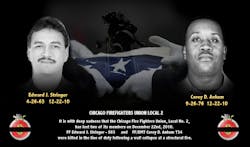Chicago: Anatomy of a Building and its Collapse
The fire was first reported at about 06:48 hours during the night and day tour shift change, with companies arriving at 06:52 hours reporting moderate fire in the buildings northeast corner. The single story commercial structure was vacant, however it was readily known that squatters were known to seek shelter in the abandoned structure especially give the harsh weather being experienced in the city. The fire was quickly contained at approximately 07:00 hours according to published reports, and radio communications, with coordinated suppression, search and rescue and ventilation operations being conduction by companied both within the interior and on the roof.
It was during this phase of operations that a mayday was rapidly communicated at 07:07 hours after a portion of the roof and rear masonry wall unexpectedly collapsed sending personnel operating on the roof riding down with the collapse and trapping four firefighters within the confines of the interior voids. RIT was immediately deployed at the scene for the trapped personnel with reports of numerous firefighters injured by the collapsing wall into the alley way on the Charlie and Delta sides.In this incident the Rules of Structural Fire Engagement were clear and resonated with the commitment and resolve that define the American Fire Service. Companies committed to tactical deployment operations consistent with departmental operating procedures and policy that required interior fire suppression, in conjunction with a coordinated interior search and rescue task assigned and supported by roof ventilation. Although the one-story brick building was clearly abandoned and vacant; it was not known if it was unoccupied, thus the tactical search and rescue assignment. According to Chicago Fire Commissioner Robert Hoff, firefighters entered the burning structure because of reports there may have been squatters inside the old laundry and cleaning facility.
By all indications this alarm was a conventional fireground operation being conducted in a fashion consistent with the operating procedures and protocols of the Chicago Fire Department (CFD), executed in a formulative manner that was predicated upon similar past building performance and operations successes. Various news reports and audio recordings of fireground communications identified that first arriving companies recognized the building and occupancy type and were aware that the building had a characteristic bowstring truss roof system in the rear (Charlie side) of the occupancy. CFD procedures dictate identification of the degree of fire involvement or impingement within the truss loft area (concealed or open area located within the open void space of the truss chords between the underdeck of the roof and the bottom chord of the truss) to determine risk and impact on further tactical operational deployment and task assignments.
The CFD is adeptly aware of the historical characteristics, hazards and safety concerns associated with firefighting operations in buildings of bowstring truss construction. The Chicagoland area has an abundance of vintage building types with an array of occupancies that have characteristic small and large span structural bowstring truss systems.
CFD Firefighters know bowstring truss roofs only too well because of the risk of collapse. Twelve years ago, two firefighters died when the bowstring truss roof collapsed on them while fighting a fire in a tire and auto repair shop in Beverly. The roof in the Beverly fire was already ablaze. In the case of 1744 East 75th Street, companies did not identify any fire extension or impingement within the truss loft area during initial phases of deployment and initiated tactical operation assignments accordingly based upon the fire location and strategic incident action plan.
FF Ankum and FF Stringer were killed by the crushing weight of the collapsed roof. With a structural support system comprised of wood timbers configured in a bowstring style truss system, this structural support system and construction style was common in the late 1920s when the building at 75th and Stony Island in South Shore was built. The truss is arched like a bowstring and provides a clear span within a room or large compartment floor area without intermediate vertical support columns. The structural truss component is typically anchored along the exterior walls where the roof load is transferred to the vertical walls and transmitted down to the foundation.
The building and occupancy at 1744 East 75th Street however did have a risk profile not related to its occupancy type and one that was not readily known to operating company or command officers during the initial stages of fireground operations; that this building was in state of disrepair and had received numerous citations and notices of action. The unstable nature of the building, the apparent poor condition of the roof and inherent deficiencies in the structural support system and construction created an operational risk profile that could not be identified readily through conventional size-up by arriving and deploying command or company officers.
It was reported that the city had previously cited the building owner for numerous building code violations; including failing to maintain the roof- which, according to the violation, had holes and was rotted and leaking. The violation also indicated the roof trusses were vented and rotted. It is not known if pre-fire plan information was readily available to responding companies or if recent first-due company level inspections or walk-thru had been initiated or completed.
In an effort to provide timely learning’s from this incident and in advance of the more thorough and detailed subsequent investigative reports and information that will be forthcoming in the months ahead, I’d like to provide some insights and basic information to increase firefighter, company and command officer awareness and knowledge related to the operational concerns for similar buildings with bowstring truss structural roof systems and share some observations related to presumptions deduced from incident scene photos. The representative insights derived from this incident are in no way meant to analyze or offer criticism towards any element of the operations conducted at 1744 East 75th Street; but are provided to increase your knowledge of building features to support operations at similar structures and occupancies so as to reduce the likelihood of other history repeating events (HRE) in your jurisdiction or response district.
These insights are based upon an analysis of incident scene photographs, internet based images and maps from Google, Bing along with video and audio media clips. Interpretations and assumptions made (especially related to dimensions, size and configurations) are representative to provide content to scale and similarities with other typical construction features in an effort to advance firefighter knowledge.
For the complete full article on the Anatomy of the Building and Collapse with building construction, operational and safety insights related to bowstring roof systems and mansonry Type III and IV construction with photos and video clips link to Buildingsonfire.com HERE or Commandsafety.com HERE
A PDF Download is attached of the complete article for training an reference use.
Remember: Building Knowledge = Firefighter Safety
Follow timely posting links related to Building Construction, Firefighting, Command Risk Management for Operational Excellence and Firefighter Safety with Buildingsonfire on Facebook HERE
About the Author
Christopher J. Naum
CHRISTOPHER J. NAUM, SFPE a Firehouse® contributing editor, is a 40-year fire service veteran and a national instructor, author, lecturer and fire officer. He is an authority on building construction issues affecting the fire and emergency services and a former fire command officer, architect and fire protection engineer. Naum is a technical consultant and reviewer to the NIOSH firefighter fatality investigation and prevention program, an NFFF Firefighter Safety Advocate and formally served on the Board of Directors of the ISFSI and the IAFC Safety, Health & Survival section and faculty at the National Fire Academy. He was the 1987 ISFSI George D. Post National Fire Instructor Award recipient. Naum is the executive producer of Buildingsonfire.com and FiregroundLeadership.com, sites dedicated to building construction, adaptive fire command and firefighter safety.

